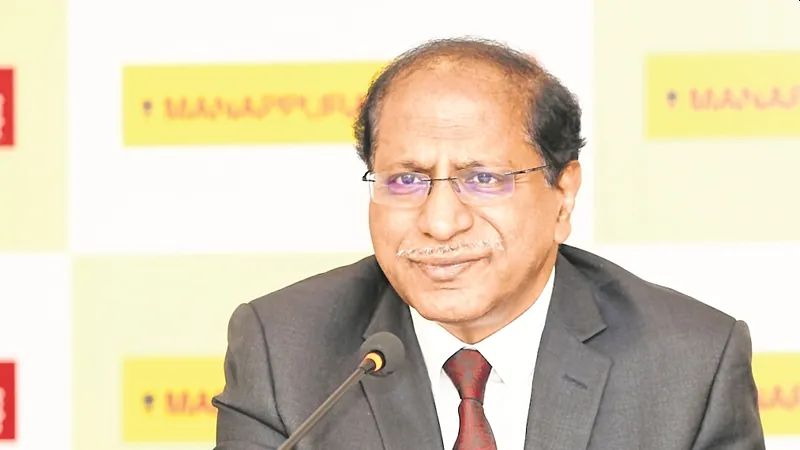https://www.freepressjournal.in/interviews/mannapuram-home-finance-could-be-a-financial-gladiator

Post the IL&FS tornado that ripped through India’s financial markets, many non-banking finance companies have bitten the dust, or have been downgraded by credit rating agencies. Manappuram group proudly displays its achievements as being one of the very few to have withstood the storm. Its strong financials helped rating agencies to upgrade the company – Manappuram Finance, and today its ratings are among the best in the industry. Taking pride in this fact, the company went a step ahead and decided to issue its maiden secured Non-Convertible Debentures (NCDs) which are available in seven options. The issue yields rates between 10% to 10.75%. V P Nandakumar, Promoter, Managing Director and CEO of Manappuram Finance, talks about the issue; and the company and its relation with gold to Jescilia Karayamparambil and R N Bhaskar.
Edited Excerpts:
Are your facing any funding issues?
Manappuram and other few companies did not face any problem. This is mainly due to the nature of our product. As a group, our major business is lending against gold and our contract is for three months.
The average life of the loan is 70 days because of the short-term nature of our lending, and thus our average borrowing is for longer period.
So, our asset-liability match is positive for us. Due to this, the commercial paper markets that were blocked for many were still available for us.
The NHB (National Housing Bank – whose functions are to be taken over by the Reserve Bank of India soon) require a minimum capital adequacy ratio comprising Tier I and Tier II capital which should not be less than 13%, 14% and 15% for fiscal 2020, 2021 and 2022 respectively – of our aggregate risk-weighted assets and risk-weighted value of off-balance-sheet items.
Our capital adequacy ratio, calculated in accordance with NHB provisions, was 62.32% as of March 31, 2019. Due to the nature of our product, we do not face any liquidity issue. The lenders continue to lend us.
When you say you borrow long-term and loan tenure is 70 days, the risk is that if you do not get another loan then your borrowing remains unutilised?
In theory, it is like that. But our AUM is growing and increasing. Our AUM (asset under management) has grown at a CAGR (compounded average growth rate) of 29.36% from Rs 31,001 lakh as of March 2017 to Rs 51,875.9 lakh as of March 2019.
At what rate is your gold loan be increasing?
We have targeted gold loan growth by 50%. We are meeting that.
What is the average cost of borrowing for the company?
Our average cost of borrowing for our parent company is 9.3%. It has gone up almost 100 bps in last one and half years. Even for Manappuram Home Finance, the borrowing rate has gone up to 9.8% which was almost 9%. So that increase in average cost borrowing is there.
The banks have not passed on their rate cuts to us. Every bank is hard pressed to report profit. Even when the repo rate was cut, the banks did not transmit that to NBFCs.

After the IL&FS crisis, did the banks perceive the entire NBFC sector as a risk?
The banks are reluctant to lend to the NBFC sector as a whole— that is a fact. In this difficult situation, as a group, our targeted CAGR is of 20% and we are growing as per our plan.
This is the most difficult situation faced by the industry—if you look back, it is the worst in NBFCs’ 20 years of history. Despite such worst situations, we are able to achieve the project growth.
Why does Maharashtra take a large share in loan portfolio of Manappuram Home Finance?
We started two businesses—vehicle finance and home finance—from Maharashtra. In case of microfinance business, our largest chuck is from Tamil Nadu.
It is because that business started from Tamil Nadu. We are growing from here to those places. In terms of gold loan demand, it is coming from Andhra Pradesh and Telangana. Other states that have good demand for gold loan include Karnataka, Tamil Nadu, Maharashtra, Kerala etc.
As of August 2019, out of 46 branches that we have, 15 branches were located in Maharashtra, and nine branches were located in Tamil Nadu constituting 32.61% and 19.57% of our total branch network respectively.
As of March 31, 2017, 2018 and 2019 respectively, 61.7%, 62.8% and 65.2% respectively of out total business were from the states of Maharashtra and Tamil Nadu.
Is Kerala not in top three in terms of gold loan portfolio?
The competition for gold loan in the organised sector in that state is very high. There are many institutions like banks and other financial institutions that have been giving gold loans in Kerala.
Do you encourage any borrower on what should be done with his or her property?
We do not have builder financing as such. We actually lend to borrowers who are the actual landowners. We do not suggest anything to him. We let the borrower decide what he wants to do with his land.
Why are you issuing yields at such a high rate?
This is our maiden public issue and there are so many players in the market already. From Kerala, two large companies—Muthoot Finance and Muthoot Fincorp—are already there.
The market is already flooded with a lot of issues. We want to broadbase our liability side. We want to diversify our liability. Our issue size is Rs 200 crore, we have a desire to raise around Rs 300 crore.
Of the various businesses that you have, gold loan is the largest. Isn’t it? How much is it?
Yes it is, around 60% is gold and 18% is microfinance. So, the balance 6% is vehicle finance; 2.5% is home finance and then there are other loans to other NBFCs. We wanted the company to go slow in vehicle finance due to the recession in the market.
The economy is not doing well. So, keeping that in mind, we want to have a reasonable growth. For us, real growth will come from gold and microfinance.
Is home loan your company’s focus?
In case of home loan, until you achieve the size of Rs 1,000 crore, growth rates are bound to be sluggish. Our focus is home loans. We believe we can disburse around Rs 30-35 crore. Currently, we are disbursing around Rs 20 crore. We are building the capacity.
Does implementation of RERA have any affect in your branch expansion?
In south, we are targeting self-constructed properties and they are not coming under RERA. We have some exposure there. We are not focussing on developers’ segments as it is not in good shape. So, our focus continues to be in self-constructed property.
Why did the cost of borrowing of the company increase?
The cost of borrowing went up because of market conditions. There was no specific jump in our case. Our borrowing cost increase is much less than what the market witnessed.
Compared to industry standards, where does your cost of customer acquisition stand?
Our cost is less, we rely more on our customer base. We have around 50,000 customers coming to our branches every day. These businesses are co-located. To create awareness among the people, this is a major driver.
What is your plan for the SME portfolio?
We are going to give it thrust as this is what the government wants too. It can be Rs 5 lakh without collaterals, relying completely on business. This will mainly go up to Rs 15 lakh. In next five-three years, we want to build 5% of our consolidated portfolio in this sector.









































COMMENTS